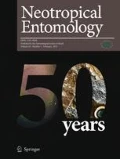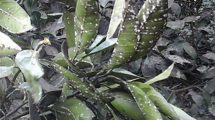Abstract
A study was instigated to examine the genetic status and distribution of known endosymbionts namely Portiera, Rickettsia, Wolbachia, Cardinium, and Arsenophonus in the populations of Bemisia tabaci (Gennadius) from three host plants: cotton (Gossypium herbaceum), okra (Abelmoschus esculentus L.), and China rose (Hibiscus rosa-sinensis) belonging to the family Malvaceae. The presence of four secondary endosymbionts Rickettsia, Wolbachia, Cardinium, and Arsenophonus was checked in Bemisia tabaci populations. Phylogenetic analyses grounded on the mitochondrial cytochrome oxidase I gene (mtCO1) unveiled the presence of Asia 1, Asia II 1, and Asia II 7 genetic groups for Bemisia tabaci on abovementioned crops. Individuals were examined for symbiotic bacterial infection with specific primers amplifying the 16S rRNA gene for Portiera, Rickettsia, Cardinium, and Wolbachia, and the 23S rRNA gene for Arsenophonus. The results show that Portiera was present in all the Bemisia tabaci samples. However, variations were noted in the circulation frequencies of secondary endosymbionts among the Bemisia tabaci populations. A significant difference was noticed in the distribution frequency of Rickettsia between cotton and China rose or okra with their p values as 0.016 and 0.033 respectively. The uneven incidence of secondary endosymbionts ropes the assumption that each endosymbiotic bacterium not only has a role in the endurance but may contribute to the polyphagous nature of Bemisia tabaci. It also brings an uncomplicated evidence for progressive studies on control measures of this notorious insect pest.





Similar content being viewed by others
References
Amann RI, Ludwig W, Schleifer KH (1995) Phylogenetic identification and in situ detection of individual microbial cells without cultivation. Microbiol Rev 59:143–169
Baumann P (2005) Biology bacteriocyte-associated endosymbionts of plant sap-sucking insects. Annu Rev Microbiol 59:155–189
Baumann P, Baumann L, Lai CY, Rouhbakhsh D, Moran NA, Clark MA (1995) Genetics, physiology, and evolutionary relationships of the genus Buchnera: intracellular symbionts of aphids. Annu Rev Microbiol 49:55–94. https://doi.org/10.1146/annurev.mi.49.100195.000415
Baumann L, Thao ML, Funk CJ, Ng JCK, Baumann P, Falk BW (2004) Sequence analysis of DNA fragments from the genome of the primary endosymbiont of the whitefly Bemisia tabaci. Curr Microbiol 48(1):77–81
Bing XL, Yang J, Zchori-Fein E, Xiao-We W, Shu-Sheng L (2013) Characterization of a newly discovered symbiont in the whitefly Bemisia tabaci (Hemiptera: Aleyrodidae). Appl Entomol Zool 79(2):569
Boykin LM, Shatters RGJ, Rosell RC, McKenzie CL, Bagnall RA, De Barro PJ, Frohlich DR (2007) Global relationships of Bemisia tabaci (Hemiptera: Aleyrodidae) revealed using Bayesian analysis of mitochondrial COI DNA sequences. Mol Phylogenet Evol 44:1306–1319
Boykin LM, Armstrong KF, Kubatko L, De Barro P (2012) Species delimitation and global biosecurity. Evol Bioinforma 8:1–37
Brune A, Ohkuma M (2001) Role of the termite gut microbiota in symbiotic digestion. In: Biology of termites: a modern synthesis. Springer Netherlands, Dordrecht, pp 439–475
Cahill M, Denholm I, Bryne FJ, Devonshire AL (1996) Insecticide resistance in Bemisia tabaci status and implications for management. Proceeding of Brighton Crop Protection Conference. Pests and Diseases 1:75–80
Chiel E, Gottlieb Y, Zchori-Fein E, Mozes-Daube N, Katzir N, Inbar M, Ghanim M (2007) Biotype-dependent secondary symbiont communities in sympatric populations of Bemisia tabaci. Bull Entomol Res 97:407–413
Chu D, Gao C, De Barro PJ, Zhang Y, Wan F, Khan I (2011) Further insights into the strange role of bacterial endosymbionts in whitefly, Bemisia tabaci: comparison of secondary symbionts from biotypes B and Q in China. Bull Entomol Res 101:477–486
Dalton R (2006) The Christmas invasion. Nature 443:898–900
De Barro PJ, Liu SS, Boykin LM, Dinsdale AB (2011) Bemisia tabaci: a statement of species status. Annu Rev Entomol 56:1–19
Dedeine F, Bouletreau M, Vavre F (2005) Wolbachia requirement for oogenesis: occurrence within the genus Asobara (Hymenoptera, Braconidae) and evidence for intraspecific variation in A. tabida. Heredity 95:394–400
Dinsdale A, Cook L, Riginos C, Buckley YM, De Barro PJ (2010) Refined global analysis of Bemisia tabaci (Hemiptera: Sternorrhyncha: Aleyrodoidae: Aleyrodidae) mitochondrial cytochrome oxidase 1 to identify species level genetic boundaries. Ann Entomol Soc Am 103:196–208
Douglas AE (1998) Nutritional interactions in insect-microbial symbioses: aphids and their symbiotic bacteria Buchnera. Annu Rev Entomol 43:17–27
Elbaz M, Lahav N, Morin S (2010) Evidence for prezygotic reproductive barrier between the B and Q biotypes of Bemisia tabaci. Bull Entomol Res 100:581–590
Ellango R, Singh ST, Rana VS, Gayatri Priya N, Raina H, Chaubey R, Naveen NC, Mahmood R, Ramamurthy VV, Asokan R, Rajagopal R (2015) Distribution of Bemisia tabaci genetic groups in India. Environ Entomol 44(4):1258–1264
Everett KDE, Thao M, Horn M, Dyszynski GE, Baumann P (2005) Novel chlamydiae in whiteflies and scale insects: endosymbionts “Candidatus Fritschea bemisiae” strain Falk and “Candidatus Fritschea eriococci” strain Elm. Int J Syst Evol Microbiol 55(Pt 4):1581–1587
Ferrari J, Darby AC, Daniell TJ, Godfray HCJ, Douglas AE (2004) Linking the bacterial community in pea aphids with host-plant use and natural enemy resistance. Ecol Entomol 29:60–65
Gherna RL, Werren JH, Weisburg W, Cote R, Woese CR, Mandelco L, Brenner DJ (1991) NOTES: Arsenophonus nasoniae gen. nov, sp. nov, the causative agent of the son-killer trait in the parasitic wasp Nasonia vitripennis. Int J Syst Evol Microbiol 41:563–565
Gnankiné O, Mouton L, Henri H, Terraz G, Houndeté T, Martin T, Vavre F, Fleury F (2013) Distribution of Bemisia tabaci (Homoptera: Aleyrodidae) biotypes and their associated symbiotic bacteria on host plants in West Africa. Insect Conserv Divers 6(3):411–421
Gottlieb Y, Ghanim M, Chiel E, Gerling D, Portnoy V, Steinberg S, Tzuri G, Horowitz AR, Belausov E, Mozes-Daube N (2006) Identification and localization of a Rickettsia sp. in Bemisia tabaci (Homoptera: Aleyrodidae). Appl Environ Microbiol 72(5):3646–3652
Gueguen G, Vavre F, Gnankine O, Peterschmitt M, Charif D, Chiel E, Gottlieb Y, Ghanim M, Zchori-Fein E, Fleury F (2010) Endosymbiont metacommunities, mtDNA diversity and the evolution of the Bemisia tabaci (Hemiptera: Aleyrodidae) species complex. Mol Ecol 19:4365–4378
Hashmi TR, Dey D, Prasad R (2016a) Diversity of associated endosymbionts of Bemisia tabaci (Gennadius) on solanaceous host plants in India. Indian J Sci Technol 9(40):1–7
Hashmi TR, Naveen NC, Dey D, Meshram NM, Prasad R (2016b) Evaluation of endosymbionts in different developmental stages of three population of Bemisia tabaci. Int J Innov Res Adv Stud 3(10):272–275
Hashmi TR, Dey D, Prasad R (2017) Distribution frequency of endosymbionts and genetic characterisation of Bemisia tabaci (Hemiptera: Aleyrodidae) on fabaceous host plants in India. Orient Insects 52:1–15. https://doi.org/10.1080/00305316.2017.1380543
Hashmi TR, Devi SR, Meshram NM, Prasad R (2018) Assessment of bacterial endosymbionts and the host, Bemisia tabaci (Hemiptera: Aleyrodidae), using rRNA and mitochondrial cytochrome oxidase I gene sequences. Commun Integr Biol (11):1, e1433442
Heddi A, Grenier AM, Khatchadourian C, Charles H, Nardon P (1999) Four intracellular genomes direct weevil biology: nuclear, mitochondrial, principal endosymbiont, and Wolbachia. Proc Natl Acad Sci U S A 96:6814–6819
Hongoh Y, Ohkuma M, Kudo T (2003) Molecular analysis of bacterial microbiota in the gut of the termite Reticulitermes speratus (Isoptera; Rhinotermitidae). FEMS Microbiol Ecol 44:231–242
Horowitz AR, Kontsedalov S, Khasdan V, Ishaaya I (2005) Biotypes B and Q of Bemisia tabaci and their relevance to neonicotinoid and pyriproxyfen resistance. Arch Insect Biochem Physiol 58:216–225
Hosokawa T, Kikuchi Y, Meng XY, Fukatsu T (2005) The making of symbiont capsule in the plataspid stinkbug Megacopta punctatissima. FEMS Microbiol Ecol 54:471–477
Jeanmougin F, Thompson JD, Gouy M, Higgins DG, Gibson TJ (1998) Multiple sequence alignment with Clustal X. Trends Biochem Sci 23(10):403–405
Jones DR (2003) Plant viruses transmitted by whiteflies. Eur J Plant Pathol 109:195–219
Kaltenpoth M, Goettler W, Dale C, Stubblefield JW, Herzner G, Roeser-Mueller K et al (2006) ‘Candidatus Streptomyces philanthi’, an endosymbiotic streptomycete in the antennae of Philanthus digger wasps. Int J Syst Evol Microbiol 56:1403–1411
Khasdan V, Levin I, Rosner A, Levin I, Rosner A, Morin S, Kontsedalov S, Maslenin L, Horowitz AR (2005) DNA markers for identifying biotypes B and Q of Bemisia tabaci (Hemiptera: Aleyrodidae) and studying population dynamics. Bull Entomol Res 95:605–613
Kimura M (1980) A simple method for estimating evolutionary rates of base substitutions through comparative studies of nucleotide sequences. J Mol Evol 16(2):111–120
Liu SS, Colvin J, De Barro PJ (2012) Species concepts as applied to the whitefly Bemisia tabaci systematics: how many species are there? J Integr Agric 11:176–186
Marubayashi JM, Kliot A, Yuki VA, Rezende JAM, Krause-Sakate R, Pavan MA, Ghanim M (2014) Diversity and localization of bacterial endosymbionts from whitefly species collected in Brazil. PLoS One 9(9):e108363. https://doi.org/10.1371/journal.pone.0108363
Montllor CB, Maxmen A, Purcell AH (2002) Facultative bacterial endosymbionts benefit pea aphids Acyrthosiphon pisum under heat stress. Ecol Entomol 27:189–195
Moran NA (2007) Symbiosis as an adaptive process and source of phenotypic complexity. Proc Natl Acad Sci U S A 104:8627–8633
Moran NA, Degnan PH, Santos SR, Dunbar HE, Ochman H (2005) The players in a mutualistic symbiosis: insects, bacteria, viruses, and virulence genes. Proc Natl Acad Sci U S A 102(47):16919–16926
Moya A, Peretó J, Gil R, Latorre A (2008) Learning how to live together: genomic insights into prokaryote–animal symbioses. Nat Rev Genet 9(3):218–229
Muyzer G, Hottentrager S, Teske A, Wawer C (1996) Denaturing gradient gel electrophoresis of PCR amplified 16s rDNA—a new molecular approach to analyze the genetic diversity of mixed microbial communities. In: Akkermans ADL, van Elsas JD, de Bruijn FJ (eds) Molecular microbial ecology manual 3.4.4. Kluwer Academic Publishers, Dordrecht, pp 1–23
Oliver KM, Russell JA, Moran NA, Hunter MS (2003) Facultative bacterial symbionts in aphids confer resistance to parasitic wasps. Proc Natl Acad Sci U S A 100:1803–1807
Pascual S, Callejas C (2004) Intra- and interspecific competition between biotypes B and Q of Bemisia tabaci (Hemiptera: Aleyrodidae) from Spain. Bull Entomol Res 94:369–375
Roopa HK, Rebijith KB, Asokan R, Mahmood R, Krishna Kumar NK (2014) Isolation and identification of culturable bacteria from honeydew of whitefly, Bemisia tabaci (G.) (Hemiptera: Aleyrodidae). Meta Gene 2:114–122
Sasaki-Fukatsu K, Koga R, Nikoh N, Yoshizawa K, Kasai S, Mihara M (2006) Symbiotic bacteria associated with stomach discs of human lice. Appl Environ Microbiol 72:7349–7352
Singh ST, Priya NG, Kumar J, Rana VS, Ellango R, Joshi A, Priyadarshini G, Asokan R, Rajagopal R (2012) Diversity and phylogenetic analysis of endosymbiotic bacteria from field caught Bemisia tabaci from different locations of North India based on 16S rDNA library screening. Infect Genet Evol 12(2):411–419
Tamura K, Stecher G, Peterson D, Filipski A, Kumar S (2013) MEGA6: molecular evolutionary genetics analysis version 6.0. Mol Biol Evol 30(12):2725–2729
Tay WT, Evans GA, Boykin LM, De Barro PJ (2012) Will the real Bemisia tabaci please stand up? PLoS One 7:e50550
Thao ML, Baumann P (2004) Evolutionary relationships of primary prokaryotic endosymbionts of whiteflies and their hosts. Appl Environ Microbiol 70(6):3401–3406
Wang P, Ruan YM, Liu SS (2010) Crossing experiments and behavioral observations reveal reproductive incompatibility among three putative species of the whitefly Bemisia tabaci. Insect Sci 17:508–516
Weeks AR, Velten R, Stouthamer R (2003) Incidence of a new sex ratio distorting endosymbiotic bacterium among arthropods. Proc Biol Sci 270(1526):1857–1865
Xu J, De Barro PJ, Liu SS (2010) Reproductive incompatibility among genetic groups of Bemisia tabaci supports the proposition that the whitefly is a cryptic species complex. Bull Entomol Res 100:359–366
Zchori-fein AE, Brown JK (2002) Diversity of prokaryotes associated with Bemisia tabaci (Gennadius) (Hemiptera: Aleyrodidae). Ann Entomol Soc Am 95(6):711–718
Acknowledgments
The authors are very grateful to Dr. V. V. Ramamurthy [Rtd. Professor] of the Division of Entomology at I.A.R.I, New Delhi, India, and Mrs. Asha Gaur [Chief Technical Officer] at I.A.R.I, New Delhi, India, for their helpful comments, suggestions, and discussion to accomplish this research work.
Author information
Authors and Affiliations
Contributions
TRH and NMM conceived and designed experiments. TRH and SRD contributed to field work, performed the experiment, and analyzed data. NMM and RP contributed reagents/materials/analysis tools/editing of the manuscript. TRH and AA wrote the manuscript.
Corresponding author
Ethics declarations
Conflict of interest
The authors declare that they have no conflict of interest.
Additional information
Edited by M J Zotti – UFPel
Rights and permissions
About this article
Cite this article
Hashmi, T.R., Devi, S.R., Ahmad, A. et al. Genetic Status and Endosymbionts Diversity of Bemisia tabaci (Gennadius) on Hosts Belonging to Family Malvaceae in India. Neotrop Entomol 48, 207–218 (2019). https://doi.org/10.1007/s13744-018-0639-y
Received:
Accepted:
Published:
Issue Date:
DOI: https://doi.org/10.1007/s13744-018-0639-y




